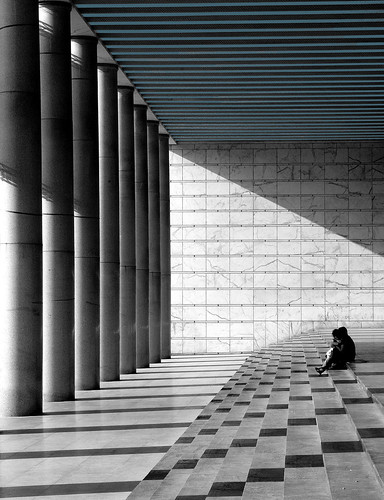It is a cold, dark December night in Rome, and I am on the grubby subway heading to Esposizione Universale Roma, or EUR, on the southern outskirts of the city, to attend a jazz concert by the sublime Brazilian artist, Cibelle. I arrive at EUR Palasport station, and am the only person to alight. I hurry upstairs into the wide Viale America and began the 10-minute walk to the concert, held in a school auditorium. Prostitutes lean against light poles, while scowling Romans in trench coats sit in their cars, cigarette in hand, browsing the ‘goods’ on display.
The wind blows across the lake, a striking contrast to the narrow, winding streets of Old Roma.
I am hungry. A pizzeria and a patisserie are open, their fluorescent glow forming halos through the foggy night sky, but they are completely empty, and I dare not enter.
I pass the imposing Banca di Roma building, which stands in darkness, a wall of glass. Some drunk teenagers pass in the opposite direction, slurring something in Italian, and I quicken my pace just a little.
I walk up the steps to the top of the hill where the auditorium sits. They are covered with slippery leaves, so I grasp the railing with one hand. A toad jumps across my path, startling me.
I finally arrive at the auditorium. A group of well-dressed Romans stand outside, chatting, laughing, smoking.
The concert is superb. Cibelle sings with the combination of sultriness and sass that I so love. Her band is funny,
When I get back to my hotel I am told that EUR is notorious for its crime, particularly for public brawls between neo-Fascist and Communist groups, and local gangs.
Still, I return the next day, eager to experience this fascinating place in daylight. I spend a good half-day walking around, photographing the monolithic structures, and drinking espresso.
EUR was conceived in the late 1930s by Fascist dictator Benito Mussolini as an out-of-town business district that would help direct the growth of Rome towards the Mediterranean sea. After Mussolini’s execution in 1945, the area continued to develop according to his original vision throughout the 1950s and 1960s, making EUR today the site of one of the finest collections of Fascist-era architecture in the world. When in EUR, you experience what Italy might have looked and felt like had it remained under Fascist rule.
It has shades of Paris’s LaDefense, and London’s Docklands. If you squint, it even feels a little like Canberra. But for me, EUR will remain in my memory as a surreal, cold, yet strangely lovable part of Rome.
Thursday, February 12, 2009
Reminiscing: EUR
Subscribe to:
Post Comments (Atom)


No comments:
Post a Comment